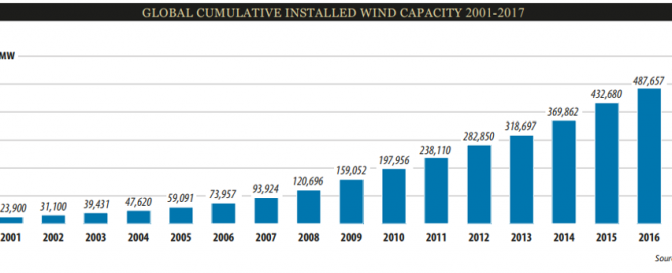The country surpassed Canada and now occupies the eighth position in the World Ranking of installed capacity of wind energy prepared by the GWEC – Global Wind Energy Council.
Brazil rose one more position in the Ranking of Installed Capacity of Wind Energy prepared by the GWEC – Global World Energy Council and now occupies eighth place. The data was released in the “GLOBAL WIND STATISTICS 2017”, an annual document with global wind energy data that shows that, in 2017, 52.57 GW of wind energy were added to world production, totaling 539.58 GW of installed capacity . The following graph shows world growth since 2001:

gwec
In the message released by GWEC along with the report, the organization assesses how the growth of wind energy has been taking place in the world. “Wind power is the most competitively priced technology in many, if not most, markets around the world, and the emergence of hybrid wind and solar power parks, more efficient grid management and storage technologies are becoming increasingly common. More affordable prices are beginning to paint a picture of what a completely fossil-free energy sector will be, ”says Steve Sawyer, GWEC Secretary General.
In the ranking of the ten countries with the highest total installed capacity of wind energy, Brazil rose one position and now appears in eighth place in the list of the largest countries, with 12.76 GW, surpassing Canada, which has 12, 39 GW. “Brazil has been climbing positions in the World Ranking of Total Installed Capacity of Wind Energy constantly. In 2015 we entered the Ranking in tenth place and, since then, we have risen one position per year ”, explains Elbia Gannoum, President of ABEEólica (Brazilian Wind Energy Association).
In the ranking of new installed capacity of the year, Brazil occupies the sixth place, having installed 2.02 GW of new capacity in 2016. In this category, Brazil fell one place, as the United Kingdom rose from ninth to fourth place, installing 4 , 27 GW. of wind capacity in 2017. “In this ranking, what counts is the specific result of the year, so there is a lot of variation. In 2012, for example, we were in eighth place and in 2015, a record installation year so far for us, we were in fourth place. The trend is that we oscillate even more, since in 2019 and 2020 our planned facilities are smaller because we were without auction for almost two years in the 2016/2017 period, which will be reflected in the results of 2019 and 2020 “, he explains Elbia.
See the full rankings below:

Today we have an installed capacity that almost reaches 13 GW, with more than 500 wind farms and we have supplied 11% of the country and more than 60% of the Northeast, while we call the “wind harvest”, which is more or less from June to November. In recent years, and especially last year, wind farms have saved the Northeast from rationing in times of low reservoirs and a red flag. Brazil has one of the best winds in the world for wind energy production and our capacity factor, which is the industry’s measure of productivity, is more than double the world average. In addition, we have an 80% nationalized production chain, which invests and generates employment here. Last year, for example, there were around 30,000 jobs. All these data are proof of a sector that has been showing its maturity. By 2020, considering only the contracts signed and the auctions already carried out, we will reach 18.63 GW. With new auctions, this number will continue to grow. It is important to remember that, today, wind farms are the most competitive contracting option, according to the result of the last auction, held in December 2017 ”, analyzes Elbia.
“In addition, wind farms have other benefits, which we can summarize as follows: it is renewable; It does not pollute; it has a very low environmental impact; contributes so that Brazil complies with the Climate Agreement; does not emit CO2 in its operation; it has one of the best cost-benefits in the energy tariff; it allows the owners of the land where the wind turbines are located to carry out other activities on the same land; generates income through the payment of leases; promotes the fixation of man in the field with sustainable development; it generates jobs from the factory to the most remote regions where the parks are located and encourages tourism by promoting regional development ”, concludes Elbia.


